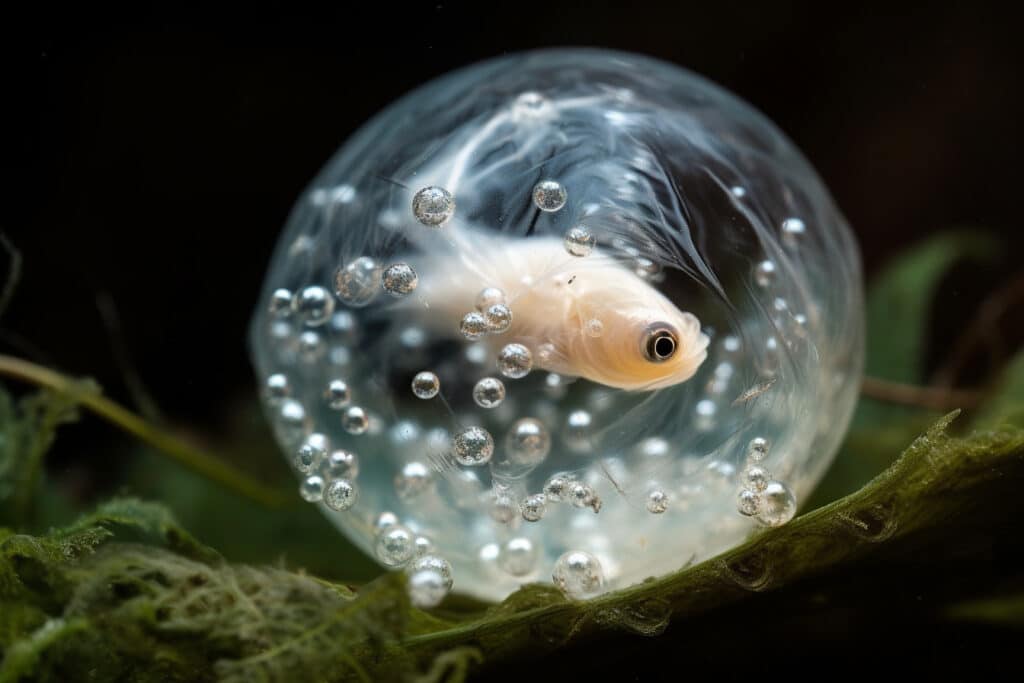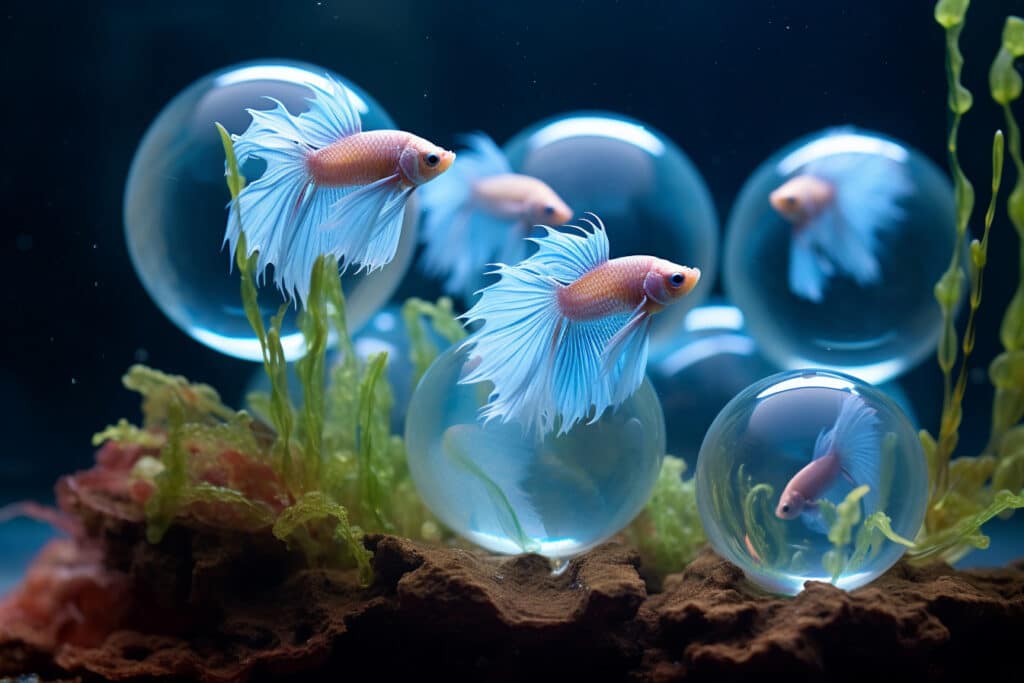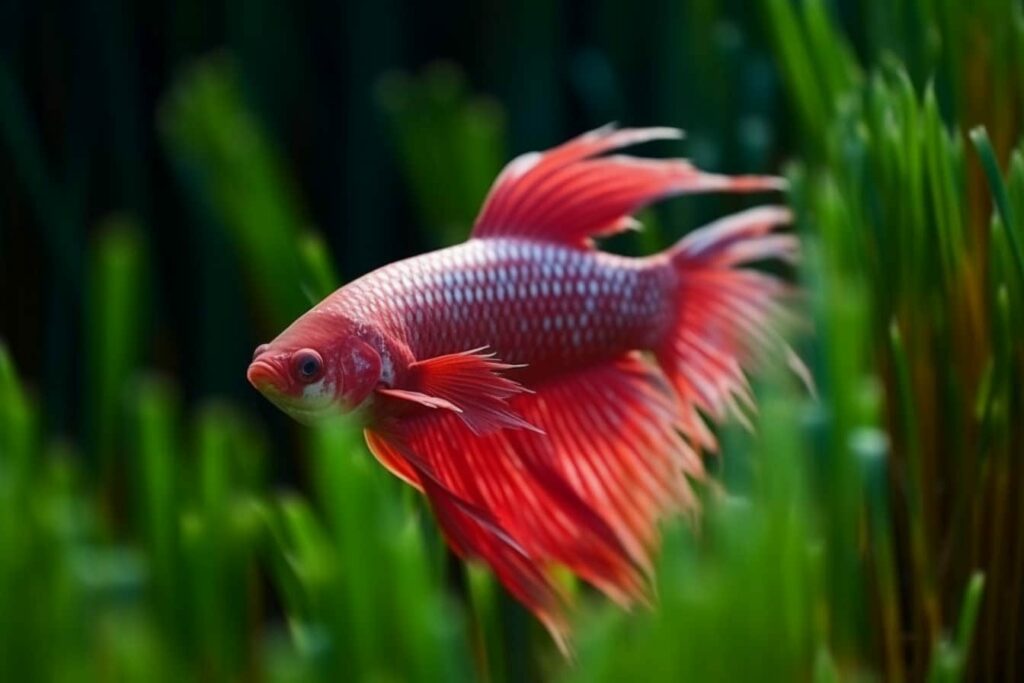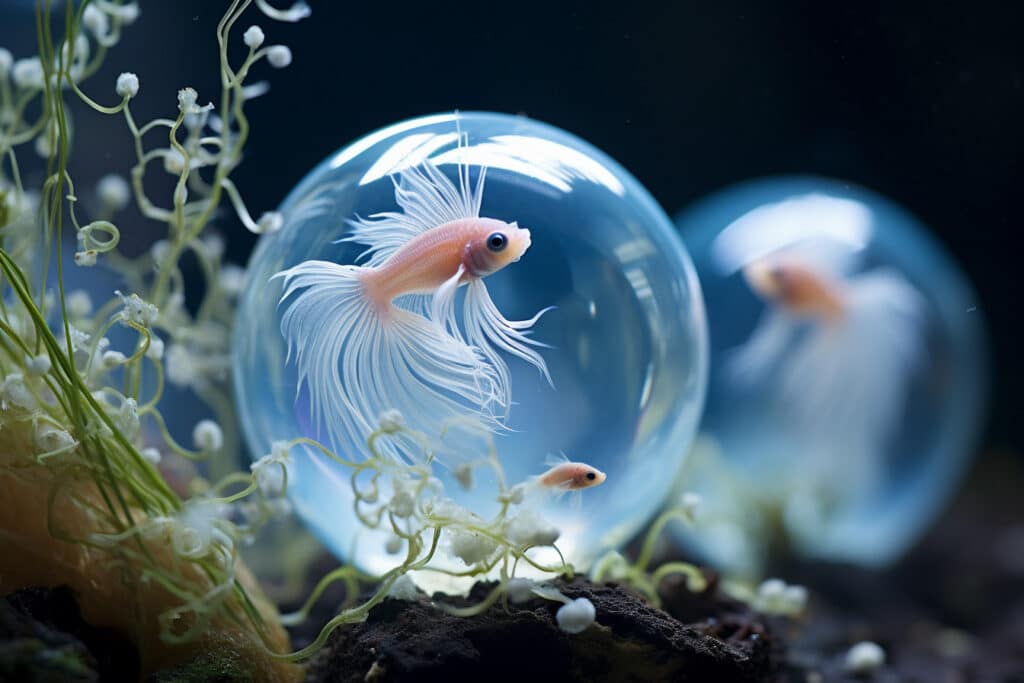Inside The Betta Bubble Nest World
The world of the Betta bubble nest! If you’ve ever observed a Betta fish creating a floating masterpiece of bubbles on the water’s surface, you’ve witnessed one of nature’s fascinating wonders.

Bubble nests are an intriguing behavior displayed by male Betta fish, scientifically known as Betta splendens. These charming aquatic creatures are renowned for their vibrant colors and flowing fins, but it’s the bubble nest building that truly captures the attention and curiosity of fish enthusiasts.
In this blog post, we will delve into the captivating realm of Betta bubble nests, exploring their purpose, construction process, and the significance they hold in the lives of these remarkable fish.
So, let’s embark on this underwater adventure and uncover the mysteries of Betta bubble nests together!
Table of Contents 🦑
The Significance of Bubble Nests in Betta Behavior

Bubble nests play a crucial role in the reproductive behavior of male Betta fish. These elaborate structures are carefully constructed by the male Betta using bubbles created from their saliva.
The purpose of the bubble nest is to provide a safe and protective environment for the eggs and the future fry. It serves as a floating nursery, ensuring the survival and development of the offspring.
The construction of a bubble nest is a fascinating sight to behold. Male Bettas meticulously gather and arrange bubbles at the water’s surface, creating a floating raft-like structure. The size and complexity of the nest can vary depending on factors such as the Betta’s age, health, and environmental conditions. A healthy and content Betta will often construct a large, robust nest, indicating their readiness for breeding.
The presence of a bubble nest also indicates the male Betta’s readiness to mate. When a male Betta builds a nest, it is a clear sign that he is prepared to court a female and engage in the intricate dance of Betta courtship. The nest serves as an invitation to the female, showcasing the male’s readiness to care for the eggs and protect the future offspring.
Bubble nests are not limited to breeding purposes alone. In some cases, male Bettas may construct bubble nests purely out of habit or instinct, even in the absence of a female or breeding conditions. It is a natural behavior that is deeply ingrained in their DNA, reflecting their innate instincts as protective and nurturing parents.
Betta Bubble Nest Variations, The Diversity of Nesting Behaviors
One of the fascinating aspects of betta bubble nests is the remarkable variety in their sizes, shapes, and structures. Male bettas exhibit a range of nesting behaviors, each unique and captivating in its own way.
Let’s take a closer look at some of the remarkable bubble nest variations and see what does a betta bubble nest look like:
The Majestic Dome
Some male bettas construct impressive dome-shaped bubble nests, resembling tiny underwater igloos. These nests can be large and intricately built, providing a cozy shelter for the eggs.
The Compact Raft
Other bettas prefer to build compact, flat bubble nests that float on the water’s surface. These nests resemble small rafts, often densely packed with bubbles, creating a stable platform for the eggs.
The Floating Cloud
Picture a cluster of fluffy bubbles scattered near the water’s surface. This ethereal arrangement, resembling a delicate cloud, is another variation of bubble nests seen in male bettas. It creates a whimsical and enchanting display in the aquarium.
The Elaborate Tower
Some male bettas showcase their architectural skills by constructing tall and slender bubble towers. These structures can reach impressive heights, serving as both a nest and a vertical landmark in the tank.
The Scattered Nest
In contrast to the organized arrangements, some bettas create bubble nests with a more scattered pattern. These nests appear as loose collections of bubbles spread across a larger surface area.
The incredible diversity in bubble nest variations highlights the innate creativity and individuality of male bettas. Each nest showcases the unique personality and nesting style of its builder.
Observing these different structures is not only visually captivating but also provides insight into the betta’s behavior and reproductive instincts.
As betta enthusiasts, we are privileged to witness and appreciate this fascinating range of bubble nest variations. It reminds us of the incredible beauty and complexity that exists within the underwater world of these remarkable fish.
So, the next time you come across a bubble nest in your betta’s tank, take a moment to marvel at the incredible diversity and admire the intricacies of nature’s designs.
Creating the Ideal Conditions for a Betta Bubble Nest
It’s time to discuss how you can create the perfect environment to encourage this natural behavior in your pet Betta fish. By providing the ideal conditions, you can help your Betta feel comfortable and inspired to construct their magnificent bubble nests.
Water Quality
Start by ensuring excellent water quality in your Betta’s aquarium. Regular water changes and the use of a reliable water conditioner will help maintain optimal water parameters, including temperature and pH levels. Clean, toxin-free water is essential for your Betta’s overall health and well-being.
Betta Tank Size and Setup
Betta fish thrive in spacious tanks that provide ample swimming room. Opt for a tank with a minimum capacity of 10 gallons to allow your Betta to express their natural behaviors fully. Additionally, consider adding live or silk plants, floating objects like Betta hammocks or leaves, and other decorations that create surface area for bubble nest construction.
Aquarium Heater
Betta fish are tropical species and they thrive in warm water temperatures, so maintaining the appropriate water temperature is crucial. Using a reliable aquarium heater, keep the water temperature between 78-82°F (25-28°C). This temperature range promotes the betta’s activity level and stimulates bubble nest-building behaviors.
Filtration System
A good filtration system is essential for maintaining water quality and promoting a healthy environment for your Betta. Choose a gentle filter with adjustable flow settings to prevent strong currents that can disturb bubble nests. It’s recommended to use a sponge or sponge filter to ensure gentle water movement while effectively removing debris and maintaining water clarity.
Proper Nutrition
A balanced and nutritious diet is vital for your Betta’s overall health and reproductive capabilities. Offer a high-quality Betta-specific pellet or flake food as their primary diet. Supplement their meals with occasional treats like freeze-dried or live foods such as bloodworms or brine shrimp to provide variety and enrichment.
Reduce Stress
Stress can hinder bubble nest building, so it’s essential to create a stress-free environment for your Betta. Avoid overcrowding the tank, minimize sudden loud noises or vibrations, and ensure the tank is placed in a peaceful location away from direct sunlight or drafts.
By implementing these guidelines, you can cultivate an environment that encourages bubble nest building and allows your Betta to showcase their natural instincts.
Remember, every Betta fish is unique, and their bubble nest-building behavior may vary. Patience and observation will help you understand and appreciate the individual preferences and habits of your delightful Betta companion.
Preserving The Betta Fish Bubble Nest

Now, let’s dive into some essential tips and considerations for maintaining and preserving these fascinating structures.
Avoid Disturbing the Nest
Bubble nests are delicate and can easily be disrupted. Avoid unnecessary disturbances in the tank, such as excessive water changes, aggressive tank cleaning, or sudden movements near the nest. These can cause the nest to break apart and discourage your Betta from rebuilding.
Regular Water Maintenance
While it’s important to minimize disruptions, regular water maintenance is still necessary to ensure a clean and healthy environment for your Betta. Perform partial water changes of about 25% every 1-2 weeks to maintain water quality. Using a siphon or gentle was appreciating the Fascinating Behavior.
Water Disturbances
Strong currents or excessive water movement can disrupt bubble nests, causing them to break apart. Adjusting the water flow, avoiding strong currents, and placing decorations strategically can help minimize disturbances and protect the nest.
Tank Cleaning
Overzealous tank cleaning practices, such as aggressive vacuuming or scrubbing near the bubble nest area, can unintentionally destroy the nest. Exercise caution while performing tank maintenance, taking care to avoid disturbing the nest or the water surface where it is located.
Aggressive Behaviors
In a community tank, aggressive tank mates, including other male bettas or fin-nipping fish, may disrupt or destroy bubble nests during territorial disputes. To prevent this, ensure proper tankmate selection and consider providing ample hiding spaces or separating bettas into individual tanks.
Observe and Appreciate
Take the time to observe and appreciate your Betta’s bubble nest-building skills. Watch as they meticulously arrange bubbles, construct walls, and tend to the nest. It’s a remarkable sight to behold and a testament to your Betta’s natural instincts.
Document and Share
Capture the beauty of your Betta’s bubble nest by taking photographs or videos. Share your experiences with fellow Betta enthusiasts and aquarium hobbyists, spreading the wonder and joy of these incredible fish.
Tank Environment Changes
Significant changes in lighting, temperature, or tank layout can disrupt the betta’s breeding behavior and result in the destruction of the bubble nest. Minimize drastic changes to the tank environment, and provide a stable and consistent habitat for your betta.
To prevent bubble nest destruction, create a calm and stress-free environment for your betta. Ensure appropriate tank conditions, compatible tank mates, and consistent care routines. If the nest is accidentally destroyed, don’t fret. Male bettas are resilient nest builders and will often rebuild their nests in a short time.
Remember, the bubble nest is not only a display of your betta’s reproductive instincts but also an indicator of their overall well-being. By providing a suitable environment and addressing potential issues, you can help your betta maintain and protect their precious bubble nest, allowing them to express their natural behaviors and thrive in your care.
Unmated Male Betta Fish Bubble Nest
Bubble nests are not limited to mated male Bettas. Even unmated male Bettas can exhibit this fascinating behavior, creating intricate and well-structured nests in their aquariums.
Understanding the occurrence of bubble nests in unmated males can provide valuable insights into their natural instincts and behaviors.
Environmental Triggers
Unmated male Bettas may build bubble nests in response to certain environmental triggers. Factors like warmer water temperatures, increased humidity, and the presence of floating plants can stimulate nest-building behavior. These conditions mimic their natural habitat and signal to the male Betta that it is an opportune time for breeding.
Display of Dominance and Territory
Bubble nests can also serve as a display of dominance and territoriality in unmated male Bettas. By building and guarding their nests, they assert their presence and establish ownership over their space. This behavior showcases their natural instinct to defend their territory and attract potential mates.
Hormonal Influence
Unmated male Bettas produce hormones that drive their nesting behavior. These hormones, such as testosterone, can influence the development and maintenance of bubble nests. The presence of these hormones, even in the absence of a female Betta, can trigger nest-building behavior as a result of their biological programming.
Behavioral Enrichment
Building bubble nests can also serve as a form of behavioral enrichment for unmated male Bettas. It provides them with mental stimulation and a sense of purpose in their environment. Nest-building allows them to engage in natural behaviors, promoting their overall well-being and reducing stress.
While bubble nests in unmated male Bettas may not have the same reproductive significance as in mated males, they offer a glimpse into the fascinating behaviors and instincts of these remarkable fish. Observing and appreciating the effort and intricacy of their bubble nests adds another layer of wonder to the world of Betta fish.
6 Tips Before Breeding Betta Fish
Before breeding betta fish, there are several important factors you should consider and be aware of:
Understanding Betta Genetics
It’s helpful to have a basic understanding of betta fish genetics, especially if you have specific goals in mind for breeding. Familiarize yourself with terms like tail types, color variations, and genetic inheritance patterns to make informed breeding decisions.
Breeding Pair Selection
Choose a healthy and compatible breeding pair. Both the male and female should be in good physical condition, free from any signs of illness or deformities. Consider their genetic traits, such as color and finnage, to achieve desired offspring characteristics.
Proper Conditioning
Before breeding, it’s important to condition both the male and female betta. Provide them with a nutritious and varied diet to enhance their overall health and reproductive readiness. High-quality foods like live or frozen brine shrimp, bloodworms, and quality betta pellets can be beneficial.
Suitable Breeding Tank
Set up a separate breeding tank that meets the specific requirements of betta breeding. The tank should be spacious enough to accommodate the breeding pair comfortably, with appropriate hiding spots and floating vegetation to encourage bubble nest building and privacy.
Monitoring and Patience
Breeding betta fish requires careful monitoring and patience. Observe the breeding pair closely, ensuring that they engage in courtship behaviors and that the male successfully builds and tends to the bubble nest. Be prepared for multiple spawning attempts and varying outcomes.
Post-Breeding Care
Once spawning occurs and fry hatch, you’ll need to provide appropriate care for the fry. Prepare suitable fry food, such as infusoria or liquid fry food, and gradually transition them to live or frozen baby brine shrimp. Separate the fry into a grow-out tank to prevent aggression and ensure their healthy development.
Remember, breeding betta fish can be a complex process, and not all breeding attempts may be successful. It requires knowledge, dedication, and responsible breeding practices. Be prepared to provide proper care for the breeding pair, fry, and any potential offspring.
FAQs About The Betta Bubble Nest
Q: How long does it take the betta eggs to fry?
A: The time it takes for betta eggs to hatch and the fry to become free-swimming baby betta fish can vary. On average, it takes around 24 to 48 hours for the eggs to hatch. Once hatched, the fry will remain attached to the nest for a few more days, feeding off their yolk sacs. After about 3 to 5 days, the fry will start to swim freely and can be considered a “free-swimming fry.” However, it’s important to note that the timing can vary depending on various factors, including water temperature, water quality, and individual betta behavior. It’s crucial to provide a stable and suitable environment for the breeding pair and closely monitor the fry’s development to ensure their well-being.
Q: Do all male bettas make bubble nests?
A: While bubble nest building is a common behavior among male bettas, it’s important to note that not all males will build bubble nests. Bubble nest building is influenced by various factors, including genetics, age, health, and environmental conditions. Some males may exhibit more pronounced nest-building behavior, while others may show little to no interest in nest construction.
Q: Are bubble nests a sign of a healthy betta fish?
A: Yes, the presence of a bubble nest can generally be considered a positive indication of a healthy betta fish. Building bubble nests is a natural and instinctive behavior displayed by male bettas when they are in good health and feel comfortable in their environment.
Q: Should I remove the bubble nest from the tank?
A: It is generally recommended not to remove the bubble nest from the tank unless there is a specific reason to do so. Bubble nests are important to male bettas as they serve as a natural behavior associated with their reproductive instincts. Removing the nest can disrupt their natural behavior and may cause stress or anxiety.
Q: Can Betta Fish Build Bubble Nests in Cold Water?
A: No, betta fish typically do not build bubble nests in cold water. Bubble nest building is a natural behavior displayed by male bettas when they are in warm water conditions. Betta fish are tropical freshwater fish and thrive in warmer temperatures ranging from 78-82°F (25-28°C). Cold water can inhibit their breeding instincts and reduce their overall activity levels.
Q: Are female betta fish making bubble nests as well?
A: No, female bettas do not typically make bubble nests. Bubble nest building is a behavior primarily exhibited by male bettas as part of their reproductive instincts. Female bettas have different reproductive roles and behaviors. They are responsible for laying and caring for the eggs, while male bettas are responsible for building and protecting the bubble nest.
Q: How long does it take a male to make a bubble nest?
A: The time it takes for a male betta to make a bubble nest can vary. It depends on various factors such as the age, health, and readiness of the betta, as well as the environmental conditions provided. Some male bettas may start building a bubble nest within a few hours or a couple of days after being introduced to a suitable tank setup, while others may take longer.
In conclusion
The world of betta bubble nests is truly fascinating and a testament to the unique behaviors of these remarkable fish. From their intricate construction to their significance in the breeding process, bubble nests offer a glimpse into the secret lives of bettas.
Whether you’re an experienced betta enthusiast or a newcomer to the world of fishkeeping, the sight of a bubble nest can bring joy and wonder. Remember, creating the ideal conditions for bubble nest building, providing a nurturing environment, and observing the behaviors of your bettas can enhance your understanding and appreciation of these magnificent creatures.
So, next time you spot a bubble nest floating on the surface of your betta’s tank, take a moment to marvel at the natural wonders they represent. Happy betta keeping!
We hope you enjoyed diving into the fascinating world of betta bubble nests with us! These quirky and enchanting creations never cease to amaze and delight. We appreciate you joining us on this bubbly adventure.
Remember, the beauty of bettas goes far beyond their stunning colors and flowing fins – it extends to their remarkable ability to build intricate bubble nests.
Thank you for being a part of our journey, and we wish you many joyful moments with your own betta fish and their amazing bubble nests. Keep exploring, keep learning, and keep bubbling with excitement!

Delighted to have you here at BettaReef! This place is a treasure trove of knowledge about Betta fish, Betta Care, Health, Gear, and much more from the wonders of aquatic life. My journey in this fascinating world began when I was just 8, and now, as a seasoned hobbyist, I’m here to help fellow Betta enthusiasts create a thriving Betta environment for a healthy life.
I’m committed to delivering high-quality content, backed by a stringent editorial process. Each product review is based on real-life usage and practical analysis, ensuring that you get insights and advice that truly matter.
Related Blog Posts:

Betta Fish Eggs The Miracle of Birth
Betta Fish Eggs The Miracle of Birth Welcome to our blog post about Betta Fish

Betta Fish Behavior Before Death
Betta Fish Behavior Before Death, Betta Fish Behavior Before Death: recognizing end-of-life signs, learn the

The Wonderful World of Female Betta Fish!
Swim To 🤿 Home The Wonderful World of Female Betta Fish These colorful and captivating
